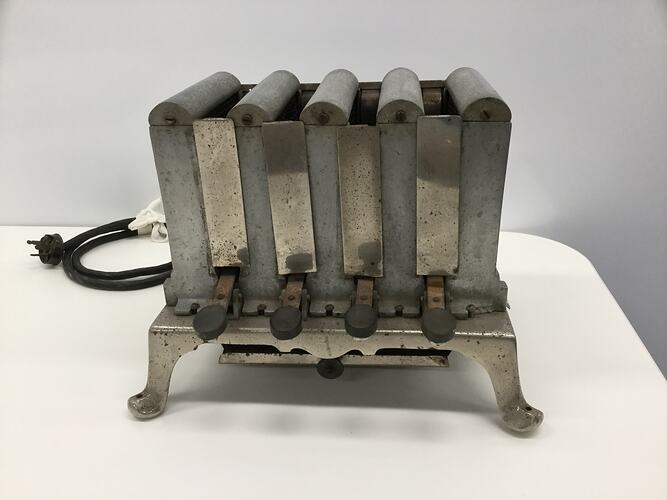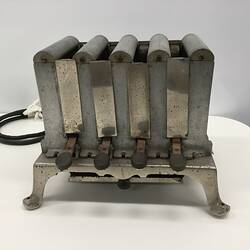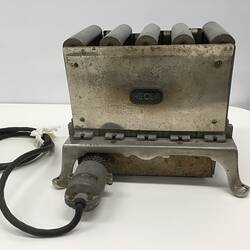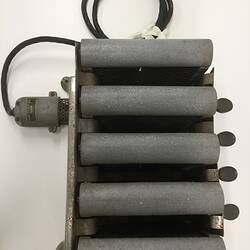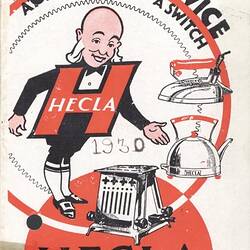Summary
Upright four-slice electric toaster, commercial model, made by Hecla Electrics Pty Ltd, Melbourne, Australia, circa 1920s.
Physical Description
Rectangular four-slice 240 volt AC electric toaster. Electro-plated metal body with individual levers with black bakelite ends for raising the slices. Crumb tray with black bakelite handle beneath the toasting unit, held up by decorative feet with holes to secure onto a bench top for commercial use. Black power supply cord with black bakelite plug connected to the toaster through a protruding metal unit at the back of the unit; metal label attached with two screws. Black glossy Hecla brand badge on the back of the unit. The toaster includes three small parts that appear to be rubber tips.
Significance
Reticulated public electric power supply in Victoria was pioneered in the 1880s by a number of private companies, the most notable of which were the Victorian Electric Lighting Co (later Australian Electric Co Limited) and the A.U. Alcock Electric Light & Motive Power Company. By 1891, both companies had established large central power stations based in Richmond with reticulated supply to the Central Business District and parts of Richmond and surrounding suburbs. In 1894, the Melbourne City Council established Victoria's first publicly-owned power utility with its own generating station in Spencer Street. As with the private undertakings, all electricity generation and distribution by the MCC was initially direct-current power with the main applications being street lighting and a few larger industrial costumers who used the power primarily for electric motors driving lifts and machinery. Distribution of electricity to domestic customers did not commence until 1897 with the MCC and private companies installed their first alternating current generators. AC power supply was initially distributed at 100 volts, later being increased to 230 volts in the early 1900s and eventually standardised on 240 volts at 50 cycles with all public power supply networks across Australia. In 1899, the remaining private power supply companies in Melbourne merged to form The Electric Lighting & Traction Company of Australia (later renamed the Melbourne Electric Supply Co in 1908). By the early 1900s, domestic electricity supply in Melbourne had extended beyond the Central Business District to cover most of the inner suburbs, with customers using power for both lighting and an increasing range of applications from heating to cooking and other household appliances.
It was within this context that Clarence William Marriott, a young Melbourne metal worker, first began manufacturing Australia's first carbon filament electric radiators in 1899. Clement Marriott's father James Marriott had commenced business in Melbourne as an art metal worker in 1872 and was later appointed as the official art metal worker to the Victorian Government producing amongst other things the ornate iron gates and gas lamp standards outside Melbourne's Parliament House. James Marriott trained his son in the business and subsequently took him into partnership, although in 1900, the business was still trading as J. Marriott of 88-90 Collins Street East, Melbourne. In 1902-4, the two designed and built one the first steam cars in Australia, but the vehicle never went into production and the business of J. Marriott & Son continued to depend largely on small scale jobbing work.
With the invention of nickel chromium wire after 1900, C.W. Marriott quickly realised the potential of the new material for making more efficient heating elements and after undertaking extensive experiments began manufacturing a range of heaters using the new type of heating element in 1916. In 1918, when Mount Heckla erupted in Iceland making worldwide news, Clarence Marriott immediately recognised that he had found the word he had been looking for sometime, something that would be immediately recognisable as being synonymous with tremendous heat and power. On 19 December 1918, he registered the brandname "HECLA" and the distinct erupting volcano logo for application to "electric heaters, heaters, electric cookers, electric water heaters and any other electrical heating appliance". Shortly afterwards he formed the company Hecla Electrics Pty Ltd. The company soon earned a reputation as Australia's leading suppler of electric heating appliances, introducing over subsequent decades an extensive range of domestic heaters, kitchen equipment, hotwater heaters and commercial heating appliances for use in cafés, hospitals and offices.
By 1923, 40,000 "Hecla" electric heaters had been sold throughout Australia, by November 1924 the number had increased to 80,000. Within two decades the company's products were being widely sold throughout Australia, New Zealand, South Africa and the south Pacific. In 1926, just five years after building new factory & showroom in Bourke Street East, the production outgrew the premises and a new 150,000 square foot factory was built on the corner or Alexandra Avenue and Chapel Street, South Yarra.
In 1928, Hecla introduced colour printing blocks in their advertisements for heaters and electric radiators and adapted the advertising slogan "By Hecla, it's Good". By late 1920s Hecla was producing electric heaters & radiators, electric foot warmers, electric kettles, ceramic & metal electric jugs, immersion hot water elements, electric fans, electric coffee percolators, electric toasters, electric grillers & stoves, electric irons and electric frypans, clocks and curling wands. Electric blankets were introduced shortly after WWII. Subsequent commercial products included hot water urns, larger commercial toasters, electric surgical and dental sterilisers, pie warmers and electric baker's ovens.
The company played an important role within the Australian domestic and commercial appliance industry, both as a leading innovator and through its role in training skilled staff, many of whom went on to work for competitors such as Electrolux and Sunbeam. When former employee Frank Banigan left the company to establish his own business in the 1960s, Hecla even sold him tooling for its K9 kettle from which he produced the first "Kambrook" electric kettles.
In 1930, a controlling 51% interest in Hecla Electrics Pty Ltd was acquired by General Electric Corporation. Manufacturing moved to the GEC plant at 296 Ferntree Gully Road, Clayton North, but the company retained its local management and identity. Under increasing competition from imports and newer Australian manufacturers Hecla went into receivership in the late 1960s, but was able to call in debtors and go back into business. In 1969 the company merged with Australian manufacturer H. Rowe & Co. Ltd. under the name Hecla Rowe Manufacturing Pty Ltd and moved its manufacturing plant to 1396 Malvern Road, Glen Iris. During the 1970s, the company withdrew more the manufacture of domestic appliances to concentrate on a more limited range of commercial products such as pie warmers, hot water urns, rubbish bins and milkshake mixers, but continued to sell imported domestic appliances such as electric kettles, electric jugs, toasters, hand-held electric mixers, electric hair driers and electric blankets manufactured in south-east Asia, but re-badged with the Hecla brandname. The business moved again to smaller premises at 1184 Glenhuntly Road, Glenhuntly, around 1980. In 1984 the Hecla business was acquired by the current owner from a holding company Hecron Limited, primarily for the brandname, which was independently assessed as being worth $5 million. Local manufacturing & service of commercial products was closed down after the purchase and the "Hecla" brandname was licensed to importers of overseas made domestic appliances such as electric kettles, toaster and vacuum cleaners. The owner still derives a substantial annual income of several hundred thousand from ongoing licensing of the "Hecla" brandname.
The collection offered to Museums Victoria consists of a small company archive and selection of typical Hecla products, put together by a dedicated employee in the late 1970s and early 1980s.
More Information
-
Collection Names
-
Collecting Areas
-
Acquisition Information
Donation from Mr Phil Wollen, 22 Oct 2004
-
Manufacturer (Probable)
-
Inscriptions
Hecla badge: HECLA Metal label: VOLTS 230 HECLA WATTS 3000 / CAT. NO. CT 1 / SUBMITTED TO / ELECTRICAL APPROVALS BOARD / REFERENCE NO. AJ/AD/01 SECV Power supply cord plug: HPM [logo lettering] / MADE IN AUSTRALIA
-
Brand Names
-
Classification
-
Category
-
Discipline
-
Type of item
-
Overall Dimensions
39 cm (Length), 33.5 cm (Width), 25.5 cm (Height)
Toasting unit with protrusions.
-
Overall Dimensions
164.5 cm (Length)
Power supply cord.
-
References
Collection includes a significant amount of archival material.
-
Keywords
